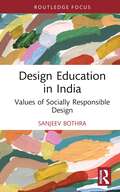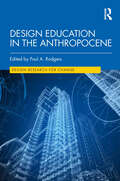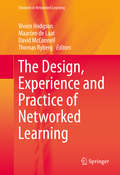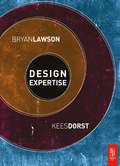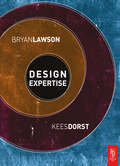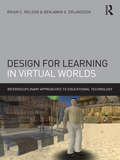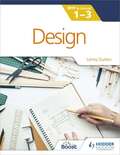- Table View
- List View
Design Education: Learning, Teaching and Researching Through Design
by Philippa LyonEmbracing the richness, complexity and possibilities of learning and teaching in design, Design Education takes the vantage point of the 'outsider' and explores what makes design so compulsively fascinating for those who teach and study it. Through more than 40 projects, from design students' use of archives and museum collections to the potential of specific technologies to enhance teaching and learning, from architecture and 3D design to fashion, Philippa Lyon explores aspects of learning and teaching in higher education design subjects. Taking an ethnographic approach and using data from interviews, discussions and observations, the book also examines issues such as the experience of design teacher-practitioners entering the world of learning and teaching research for the first time. Design Education encapsulates and analyzes the research findings facilitated by the UK-based Centre for Excellence in Teaching and Learning Through Design. It delves into many pedagogical terms and assumptions and guides the reader through them, examining the way relevant key concepts in design are articulated. It will be useful to teachers and students of design subjects, learning and interpretation staff in museums, pedagogical researchers, other centres for excellence in teaching and learning (particularly those which are art and design-related), independent design practitioners and managers of art and design provision in the public and private sector.
Design Education: A Special Issue of the Journal of the Learning Sciences
by Wendy C. NewstetterFirst published in 2000. Routledge is an imprint of Taylor & Francis, an informa company.
Design Education Across Disciplines: Transformative Learning Experiences for the 21st Century
by Miikka J. Lehtonen Tomi Kauppinen Laura SivulaThis book explores how design thinking can transform higher education, with solutions ranging from single course sessions to whole programs and universities. The authors demonstrate how designing across disciplines is done, with disruptive technologies, ambiguity and challenges as catalysts. Iteratively tested pedagogies, design-driven solutions and creative uses of both tactile and digital worlds are among the approaches discussed. Educators and leaders of higher education institutes as well as designers and managers of companies will benefit from engaging the design ideas in their own work.
Design Education in India: Values of Socially Responsible Design (Routledge Research in Social Design)
by Sanjeev BothraThis book traces developments in design education in India and shows the continuing impact of the Bauhaus School of design education, which formed the basis of the National Institute of Design. It presents the findings of the author's research and experiential learning as a design educator over a 25-year period. This book argues that as the effects of climate change and the exploitation of natural and human resources become more pervasive, it has become increasingly important to ensure that the values of social responsibility are instilled into the design students who will become future practitioners. This book offers an alternative model of understanding regarding the ecosystem of design and sustainable design education. Going beyond description and analysis, it includes three case studies of adoptable design curricula created by the author, with student responses to the programmes to provide first-hand insights into their impact. Research findings are based on detailed interviews with contemporary faculty members, all experts in the various design disciplines, along with an in-depth survey of existing design programmes in India. Design Education in India encourages a paradigm shift in thinking about the environment, spaces and places. It offers a unique perspective on the status of design education in an important and fast-growing economy and will be a useful read for design educators and researchers in varied disciplines.
Design Education in India: Values of Socially Responsible Design (Routledge Research in Social Design)
by Sanjeev BothraThis book traces developments in design education in India and shows the continuing impact of the Bauhaus School of design education, which formed the basis of the National Institute of Design. It presents the findings of the author's research and experiential learning as a design educator over a 25-year period. This book argues that as the effects of climate change and the exploitation of natural and human resources become more pervasive, it has become increasingly important to ensure that the values of social responsibility are instilled into the design students who will become future practitioners. This book offers an alternative model of understanding regarding the ecosystem of design and sustainable design education. Going beyond description and analysis, it includes three case studies of adoptable design curricula created by the author, with student responses to the programmes to provide first-hand insights into their impact. Research findings are based on detailed interviews with contemporary faculty members, all experts in the various design disciplines, along with an in-depth survey of existing design programmes in India. Design Education in India encourages a paradigm shift in thinking about the environment, spaces and places. It offers a unique perspective on the status of design education in an important and fast-growing economy and will be a useful read for design educators and researchers in varied disciplines.
Design Education in the Anthropocene (Design Research for Change)
by Paul A. RodgersThis volume examines emerging practice and research in design education rooted in the context of significant global issues.A diverse set of international contributors present novel design education research that seeks to make significant social, economic, cultural and environmental change. Topics covered include fashion, sustainability, creativity, social justice, museum education, climate change, environmentalism, and empathy. The chapters draw a link between current research practice and theory and future challenges for the field.The book will be of interest to scholars working in communication design, graphic design, design research, and information design.
Design Education in the Anthropocene (Design Research for Change)
This volume examines emerging practice and research in design education rooted in the context of significant global issues.A diverse set of international contributors present novel design education research that seeks to make significant social, economic, cultural and environmental change. Topics covered include fashion, sustainability, creativity, social justice, museum education, climate change, environmentalism, and empathy. The chapters draw a link between current research practice and theory and future challenges for the field.The book will be of interest to scholars working in communication design, graphic design, design research, and information design.
Design Education Today: Technical Contexts, Programs and Best Practices
by Dirk Schaefer Graham Coates Claudia EckertThis book provides extensive information on the key technical design disciplines, education programs, international best practices and modes of delivery that are aimed at preparing a trans-disciplinary design workforce for the future. It also presents a comprehensive overview of the scope of, and state of the art in, design education. The book highlights signature design education programs from around the globe and across all levels, in both traditional and distance learning settings. Additionally, it discusses professional societies for designers and design educators, as well as the current standards for professional registration, and program accreditation. Reflecting recent advances and emerging trends, it offers a valuable handbook for design practitioners and managers, curriculum designers and program leaders alike. It will also be of interest to students and academics looking to develop a career related to the more technical aspects of design.
Design, Evaluation, and Analysis of Questionnaires for Survey Research (Wiley Series in Survey Methodology)
by Willem E. Saris Irmtraud N. GallhoferPraise for the First Edition “...this book is quite inspiring, giving many practical ideas for survey research, especially for designing better questionnaires.” —International Statistical Review Reflecting modern developments in the field of survey research, the Second Edition of Design, Evaluation, and Analysis of Questionnaires for Survey Research continues to provide cutting-edge analysis of the important decisions researchers make throughout the survey design process. The new edition covers the essential methodologies and statistical tools utilized to create reliable and accurate survey questionnaires, which unveils the relationship between individual question characteristics and overall question quality. Since the First Edition, the computer program Survey Quality Prediction (SQP) has been updated to include new predictions of the quality of survey questions on the basis of analyses of Multi-Trait Multi-Method experiments. The improved program contains over 60,000 questions, with translations in most European languages. Featuring an expanded explanation of the usage and limitations of SQP 2.0, the Second Edition also includes: • New practice problems to provide readers with real-world experience in survey research and questionnaire design • A comprehensive outline of the steps for creating and testing survey questionnaires • Contemporary examples that demonstrate the many pitfalls of questionnaire design and ways to avoid similar decisions Design, Evaluation, and Analysis of Questionnaires for Survey Research, Second Edition is an excellent textbook for upper-undergraduate and graduate-level courses in methodology and research questionnaire planning, as well as an ideal resource for social scientists or survey researchers needing to design, evaluate, and analyze questionnaires. Design, Evaluation, and Analysis of Questionnaires for Survey Research, Second Edition is an excellent textbook for upper-undergraduate and graduate-level courses in methodology and research questionnaire planning, as well as an ideal resource for social scientists or survey researchers needing to design, evaluate, and analyze questionnaires.Reflecting modern developments in the field of survey research, the Second Edition of Design, Evaluation, and Analysis of Questionnaires for Survey Research continues to provide cutting-edge analysis of the important decisions researchers make throughout the survey design process. The new edition covers the essential methodologies and statistical tools utilized to create reliable and accurate survey questionnaires, which unveils the relationship between individual question characteristics and overall question quality. Since the First Edition, the computer program Survey Quality Prediction (SQP) has
Design, Evaluation, and Analysis of Questionnaires for Survey Research (Wiley Series in Survey Methodology)
by Willem E. Saris Irmtraud N. GallhoferPraise for the First Edition “...this book is quite inspiring, giving many practical ideas for survey research, especially for designing better questionnaires.” —International Statistical Review Reflecting modern developments in the field of survey research, the Second Edition of Design, Evaluation, and Analysis of Questionnaires for Survey Research continues to provide cutting-edge analysis of the important decisions researchers make throughout the survey design process. The new edition covers the essential methodologies and statistical tools utilized to create reliable and accurate survey questionnaires, which unveils the relationship between individual question characteristics and overall question quality. Since the First Edition, the computer program Survey Quality Prediction (SQP) has been updated to include new predictions of the quality of survey questions on the basis of analyses of Multi-Trait Multi-Method experiments. The improved program contains over 60,000 questions, with translations in most European languages. Featuring an expanded explanation of the usage and limitations of SQP 2.0, the Second Edition also includes: • New practice problems to provide readers with real-world experience in survey research and questionnaire design • A comprehensive outline of the steps for creating and testing survey questionnaires • Contemporary examples that demonstrate the many pitfalls of questionnaire design and ways to avoid similar decisions Design, Evaluation, and Analysis of Questionnaires for Survey Research, Second Edition is an excellent textbook for upper-undergraduate and graduate-level courses in methodology and research questionnaire planning, as well as an ideal resource for social scientists or survey researchers needing to design, evaluate, and analyze questionnaires. Design, Evaluation, and Analysis of Questionnaires for Survey Research, Second Edition is an excellent textbook for upper-undergraduate and graduate-level courses in methodology and research questionnaire planning, as well as an ideal resource for social scientists or survey researchers needing to design, evaluate, and analyze questionnaires.Reflecting modern developments in the field of survey research, the Second Edition of Design, Evaluation, and Analysis of Questionnaires for Survey Research continues to provide cutting-edge analysis of the important decisions researchers make throughout the survey design process. The new edition covers the essential methodologies and statistical tools utilized to create reliable and accurate survey questionnaires, which unveils the relationship between individual question characteristics and overall question quality. Since the First Edition, the computer program Survey Quality Prediction (SQP) has
The Design, Experience and Practice of Networked Learning (Research in Networked Learning)
by Vivien Hodgson Maarten De Laat David McConnell Thomas RybergThe Design, Experience and Practice of Networked LearningEdited by: Vivien Hodgson, Maarten de Laat, David McConnell and Thomas RybergThis book brings together a wealth of new research that opens up the meaning of connectivity as embodied and promised in the term ‘networked learning’. Chapters explore how contexts, groups and environments can be connected rather than just learners; how messy, unexpected and emergent connections can be made rather than structured and predefined ones; and how technology connects us to learning and each other, but also shapes our identity. These exciting new perspectives ask us to look again at what we are connecting and to revel in new and emergent possibilities arising from the interplay of social actors, contexts, technologies, and learning.Caroline Haythornthwaite, University of British ColumbiaDespite creating fundamentally new educational economics and greatly increasing access - teaching and learning in networks is a tricky business. These chapters illuminate the complex interactions amongst tools, pedagogy, educational institutions and personal net presences – helping us design and redesign our own networks. In the process, they take (or extract) network theory from the practice of real teaching and learning contexts, making this collection an important contribution to Networked Learning.Terry Anderson, Athabasca UniversityWhat kinds of learning can social networking platforms really enable? Digging well beneath the hype, this book provides a timely, incisive analysis of why and how learning emerges (or fails to) in networked spaces. The editors do a fine job in guiding the reader through the rich array of theories and methods for tackling this question, and the diverse contexts in which networked learning is now being studied. This is a book for reflective practitioners as well as academics: the book's close attention to the political, pedagogical and organisational complexity of effective practice, and the lived experience of educators and learners, helps explain why networked learning has such disruptive potential — but equally, why it draws resistance from the establishment.Simon Buckingham Shum, The Open UniversityThe networked learning conference, a biannual institution since 1998, celebrates its 14th year in this volume. Here a range of studies, reflecting networked learning experiments across Europe and other global contexts , show important shifts away from a conservative tradition of Œe-learning¹ research and unpeel dilemmas of promoting learning as an elusive practice in virtual environments. The authors point towards important futures in online learning research, where notions of knowledge, connectivity and Œcommunity¹ become increasingly elastic, and engagements slide across material and virtual domains in new practices whose emergence is increasingly difficult to apprehend.Tara Fenwick – University of Stirling.The chapters in this volume explore new and innovative ways of thinking about the nature of networked learning and its pedagogical values and beliefs. They pose a challenge to us to reflect on what we thought networked learning was 15 year ago, where it is today and where it is likely to be headed. Each chapter brings a particular perspective to the themes of design, experience and practice of networked learning, the chosen focus of the book. The chapters in the book embrace a wide field of educational areas including those of higher education, informal learning, work-based learning, continuing professional development, academic staff development, and management learning.The Design, Experience and Practice of Networked Learning will prove indispensable reading for researchers, teachers, consultants, and instructional designers in higher and continuing education; for those involved in staff and educational development, and for those studying post graduate qualifications in learning and teaching.This, the second volume in the Springer Book Series on Researching Networked Learning, is based on a selection of papers presented at the 2012 Networked Learning Conference
Design Expertise
by Bryan Lawson Kees DorstDesign Expertise explores what it takes to become an expert designer.It examines the perception of expertise in design and asks what knowledge, skills, attributes and experiences are necessary in order to design well. Bryan Lawson and Kees Dorst develop a new model of design expertise and show how design expertise can be developed. This book is designed for all students, teachers, practitioners and researchers in architecture and design. To enable all readers to explore the book in a flexible way, the authors’ words are always found on the left hand page. On the right are diagrams, illustrations and the voices of designers, teachers and students and occasionally others too. 'Design Expertise' provides a provocative new reading on the nature of design and creative thought.
Design Expertise
by Bryan Lawson Kees DorstDesign Expertise explores what it takes to become an expert designer.It examines the perception of expertise in design and asks what knowledge, skills, attributes and experiences are necessary in order to design well. Bryan Lawson and Kees Dorst develop a new model of design expertise and show how design expertise can be developed. This book is designed for all students, teachers, practitioners and researchers in architecture and design. To enable all readers to explore the book in a flexible way, the authors’ words are always found on the left hand page. On the right are diagrams, illustrations and the voices of designers, teachers and students and occasionally others too. 'Design Expertise' provides a provocative new reading on the nature of design and creative thought.
Design for Change: Designing Evidence-Based Teacher Preparation Programs
by Alan BainThis book focuses on enhancing teacher education quality by making evidence- informed decisions about policy, assessing quality, establishing effective strategies, and innovating teacher preparation programs. It advocates for the importance of rigorous program design and evaluation as the basis for shaping policy directions and claiming program effectiveness. The book introduces "Design for Change" (DfC), a 20-year-long collaborative effort by a group of teacher educators dedicated to improving their practices. DfC is divided into two parts: Design for Change-Teams and Process (DfC-TaP) and Design for Change-Programs and Courses (DfC-PaC). DfC-TaP explores how to form and sustain a design team of academics, emphasizing the collaborative process's value in program development. DfC-PaC delves into applying practical theory to curriculum design, mapping programs to standards, creating meaningful learning and assessment tasks, and leveraging technology. The latterincludes a chapter on software for teacher preparation program design. The book's ultimate goal is to offer a versatile framework for designing teacher education programs. The book employs evidence from longitudinal research to present generalizable concepts and structures for program developers and designers. By doing so, the book aims to contribute to the field by providing a research-based guide for building teacher education programs that enhance the overall educational experience for both faculty and students.
Design for Change in Higher Education
by Jeffrey T. Grabill Sarah Gretter Erik SkogsbergIt's time to design the next iteration of higher education.There is no question that higher education faces significant challenges. Most of today's universities aren't prepared to tackle issues like demographic change, the continued defunding of public education, cost pressures, and the opportunities and challenges of educational technologies. Then, of course, there is the shock of the COVID-19 pandemic, which will reverberate for years and may very well usher higher education into an era of significant structural change. Some critics argue that a premium should be placed on change functions—that is to say, on creativity, innovation, organizational learning, and change management. Yet few institutions of higher education have functions focused on thoughtful, iterative problem-solving and opportunity identification. The authors of Design for Change in Higher Education argue that we must imagine and actively make our way to new institutional forms. They assert that design—a practical art that is conceptually rich and visible in its concreteness—must become a core internal competency of the university. They propose one grounded in the practical experiences of a specific educational design organization: Michigan State University's Hub for Innovation in Learning and Technology, which all three authors have helped to run. The Hub was created to address issues of participation, impact, and scale in moving learning innovations from the individual to the collective and from the classroom to the institution. Framing each chapter around a case study of design practice in higher education, the book uses that case study as the foundation on which to build design theory for higher education. It is complemented by an online playbook featuring tactics that can be used and adapted by others interested in facilitating their own design work.Touching on learning experience design (LXD) as an increasingly critical practice, the authors also develop a constructivist view of designing conversations. A playbook that grounds theory in practice, Design for Change in Higher Education is aimed at faculty, staff, and students engaged in the important work of imagining new forms of education.
Design for Change in Higher Education
by Jeffrey T. Grabill Sarah Gretter Erik SkogsbergIt's time to design the next iteration of higher education.There is no question that higher education faces significant challenges. Most of today's universities aren't prepared to tackle issues like demographic change, the continued defunding of public education, cost pressures, and the opportunities and challenges of educational technologies. Then, of course, there is the shock of the COVID-19 pandemic, which will reverberate for years and may very well usher higher education into an era of significant structural change. Some critics argue that a premium should be placed on change functions—that is to say, on creativity, innovation, organizational learning, and change management. Yet few institutions of higher education have functions focused on thoughtful, iterative problem-solving and opportunity identification. The authors of Design for Change in Higher Education argue that we must imagine and actively make our way to new institutional forms. They assert that design—a practical art that is conceptually rich and visible in its concreteness—must become a core internal competency of the university. They propose one grounded in the practical experiences of a specific educational design organization: Michigan State University's Hub for Innovation in Learning and Technology, which all three authors have helped to run. The Hub was created to address issues of participation, impact, and scale in moving learning innovations from the individual to the collective and from the classroom to the institution. Framing each chapter around a case study of design practice in higher education, the book uses that case study as the foundation on which to build design theory for higher education. It is complemented by an online playbook featuring tactics that can be used and adapted by others interested in facilitating their own design work.Touching on learning experience design (LXD) as an increasingly critical practice, the authors also develop a constructivist view of designing conversations. A playbook that grounds theory in practice, Design for Change in Higher Education is aimed at faculty, staff, and students engaged in the important work of imagining new forms of education.
Design for Enhancing Eco-efficiency of Energy-related Products: The Integration of Simplified LCA Tools in Industrial Design Education (SpringerBriefs in Applied Sciences and Technology)
by Suphichaya Suppipat Treechada Chotiratanapinun Kulthida Teachavorasinskun Allen H. HuThis brief textbook underpins the concept of eco-efficiency in product design and systematically addresses the essence of the integration of simplified life cycle assessment (LCA) methods and tools into industrial design. Fundamental steps of LCA-based tools implementation within the higher education context are proposed, using energy-related products (ErP) design as a prime case study. All chapters are designed to respond to the common frequently asked questions in LCA-based tools implementation during the sustainable product design process. The chapters are also enriched with discussions, data sources of simplified LCA tools, and examples of design assignments that provide constructive learning. Some assignments aim at encouraging tool users’ reflections while others tackle particularly at knowledge exchange. The examples can assist the reader to visualize challenges and opportunities to engage learners who are tool users. This textbook broadens LCA knowledge for industrial design and environmental engineering students as well as enhance their sustainable product design performance. For professional practitioners including industrial designers, product engineers, entrepreneurs and the like, this textbook can be used as a guide at the introductory level for integrating life cycle thinking into product design and development.
Design for Learning in Virtual Worlds
by Brian C. Nelson Benjamin E. ErlandsonDesign for Learning in Virtual Worlds, the first book focused specifically on how to design virtual worlds for educational purposes, explores: • the history and evolution of virtual worlds • the theories behind the use of virtual worlds for learning • the design of curricula in virtual worlds • design guidelines for elements experienced in virtual worlds that support learning • design guidelines for learning quests and activities in virtual worlds. The authors also examine the theories and associated design principles used to create embedded assessments in virtual worlds. Finally, a framework and methodology is provided to assist professionals in evaluating "off-the-shelf" virtual worlds for use in educational and training settings. Design for Learning in Virtual Worlds will be invaluable both as a professional resource and as a textbook for courses within Educational Technology, Learning Sciences, and Library Media programs that focus on gaming or online learning environments.
Design for Learning in Virtual Worlds
by Brian C. Nelson Benjamin E. ErlandsonDesign for Learning in Virtual Worlds, the first book focused specifically on how to design virtual worlds for educational purposes, explores: • the history and evolution of virtual worlds • the theories behind the use of virtual worlds for learning • the design of curricula in virtual worlds • design guidelines for elements experienced in virtual worlds that support learning • design guidelines for learning quests and activities in virtual worlds. The authors also examine the theories and associated design principles used to create embedded assessments in virtual worlds. Finally, a framework and methodology is provided to assist professionals in evaluating "off-the-shelf" virtual worlds for use in educational and training settings. Design for Learning in Virtual Worlds will be invaluable both as a professional resource and as a textbook for courses within Educational Technology, Learning Sciences, and Library Media programs that focus on gaming or online learning environments.
Design for Sustainable Inclusion: CWUAAT 2023
by Joy Goodman-Deane Hua Dong Ann Heylighen Jonathan Lazar John ClarksonThis book, Design for Sustainable Inclusion, was inspired and informed by the United Nations Sustainable Development Goals. These include, among others, ‘good health and well-being’, ‘reduced inequalities’ and ‘sustainable cities and communities’. Addressing this challenge requires a cross-disciplinary approach and close collaboration with many stakeholders. The Cambridge Workshop on Universal Access and Assistive Technology (CWUAAT) 2023 invited participants from a wide variety of disciplines to contribute to the discussion on this topic.This book represents the papers presented at this conference, chosen by peer review by an international panel of currently active researchers. The chapters within the book provide a unique insight into current national and international research in the fields of inclusive design, universal access, and assistive and rehabilitative technology. The main sections of the book reflect the following key themes:• Understanding people• Designing for an ageing population• Inclusive built environments• Healthcare• Assistive technology• Design methods• Education and trainingWe hope that this book will be useful to researchers, teachers, students and the general public who are interested in inclusive design and sustainable development.
Design for Teaching and Learning in a Networked World: 10th European Conference on Technology Enhanced Learning, EC-TEL 2015, Toledo, Spain, September 15-18, 2015, Proceedings (Lecture Notes in Computer Science #9307)
by Gráinne Conole Tomaž Klobučar Christoph Rensing Johannes Konert Élise LavouéThis book constitutes the refereed proceedings of the 10th European Conference on Technology Enhanced Learning, EC-TEL 2015, held in Toledo, Spain, in September 2015. The 27 full papers, 19 short papers, 9 demo papers and 23 posters were carefully reviewed and selected from 176 submissions. They address topics such as blended learning; self-regulated and self directed learning; reflective learning; intelligent learning systems; learning communities; learning design; learning analytics; learning assessment; personalization and adaptation; serious games; social media; massive open online courses (MOOCs); schools of the future.
Design for the Changing Educational Landscape: Space, Place and the Future of Learning
by Andrew Harrison Les HuttonThe whole landscape of space use is undergoing a radical transformation. In the workplace a period of unprecedented change has created a mix of responses with one overriding outcome observable worldwide: the rise of distributed space. In the learning environment the social, political, economic and technological changes responsible for this shift have been further compounded by constantly developing theories of learning and teaching, and a wide acceptance of the importance of learning as the core of the community, resulting in the blending of all aspects of learning into one seamless experience. This book attempts to look at all the forces driving the provision and pedagogic performance of the many spaces, real and virtual, that now accommodate the experience of learning and provide pointers towards the creation and design of learning-centred communities. Part 1 looks at the entire learning universe as it now stands, tracks the way in which its constituent parts came to occupy their role, assesses how they have responded to a complex of drivers and gauges their success in dealing with renewed pressures to perform. It shows that what is required is innovation within the spaces and integration between them. Part 2 finds many examples of innovation in evidence across the world – in schools, the higher and further education campus and in business and cultural spaces – but an almost total absence of integration. Part 3 offers a model that redefines the learning landscape in terms of learning outcomes, mapping spatial requirements and activities into a detailed mechanism that will achieve the best outcome at the most appropriate scale. By encouraging stakeholders to creating an events-based rather than space-based identity, the book hopes to point the way to a fully-integrated learning landscape: a learning community.
Design for the Changing Educational Landscape: Space, Place and the Future of Learning
by Andrew Harrison Les HuttonThe whole landscape of space use is undergoing a radical transformation. In the workplace a period of unprecedented change has created a mix of responses with one overriding outcome observable worldwide: the rise of distributed space. In the learning environment the social, political, economic and technological changes responsible for this shift have been further compounded by constantly developing theories of learning and teaching, and a wide acceptance of the importance of learning as the core of the community, resulting in the blending of all aspects of learning into one seamless experience. This book attempts to look at all the forces driving the provision and pedagogic performance of the many spaces, real and virtual, that now accommodate the experience of learning and provide pointers towards the creation and design of learning-centred communities. Part 1 looks at the entire learning universe as it now stands, tracks the way in which its constituent parts came to occupy their role, assesses how they have responded to a complex of drivers and gauges their success in dealing with renewed pressures to perform. It shows that what is required is innovation within the spaces and integration between them. Part 2 finds many examples of innovation in evidence across the world – in schools, the higher and further education campus and in business and cultural spaces – but an almost total absence of integration. Part 3 offers a model that redefines the learning landscape in terms of learning outcomes, mapping spatial requirements and activities into a detailed mechanism that will achieve the best outcome at the most appropriate scale. By encouraging stakeholders to creating an events-based rather than space-based identity, the book hopes to point the way to a fully-integrated learning landscape: a learning community.
Design for the IB MYP 1-3: By Concept
by Lenny DuttonEnsure your students navigate the MYP framework with confidence using a concept-driven and assessment-focused approach to Design, presented in global contexts. - Develop conceptual understanding with key concepts and related concepts, set in global contexts, at the heart of each chapter. -Prepare for every aspect of assessment using support and tasks designed by an experienced educator. - Extend learning through research projects and interdisciplinary opportunities. - Apply global contexts in meaningful ways with an internationally-minded perspective. - Develop practical and creative-thinking skills to solve design problems with a statement of inquiry in each chapter. - Confidently cover the framework with chapters covering digital, product and combined design.
Design for the IB MYP 1-3: By Concept
by Lenny DuttonEnsure your students navigate the MYP framework with confidence using a concept-driven and assessment-focused approach to Design, presented in global contexts. - Develop conceptual understanding with key concepts and related concepts, set in global contexts, at the heart of each chapter. -Prepare for every aspect of assessment using support and tasks designed by an experienced educator. - Extend learning through research projects and interdisciplinary opportunities. - Apply global contexts in meaningful ways with an internationally-minded perspective. - Develop practical and creative-thinking skills to solve design problems with a statement of inquiry in each chapter. - Confidently cover the framework with chapters covering digital, product and combined design.



